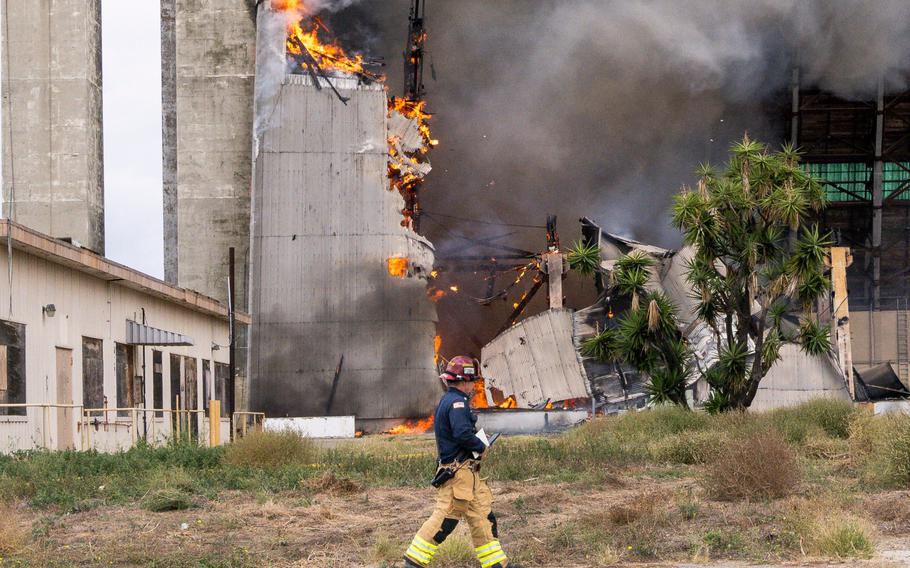Navy
Minute-by-minute account provides details for how firefighters battled Tustin hangar fire
The Orange County Register December 19, 2023

Orange County firefighters battle a fire affecting the north hangar at the former Marine Corps Air Station Tustin in Tustin, CA on Tuesday, Nov. 7, 2023. (Paul Bersebach, Orange County Register/SCNG/TNS)
(Tribune News Service) — When firefighters arrived on the scene the night the hangar fire broke out at the long-closed Tustin Marine Corps Air Station, they encountered fire hydrants that didn’t work and a blaze they couldn’t extinguish before it burned through nearly all of the enormous structure.
The cause of the fire is still under investigation and cleanup efforts continue in the neighborhoods around the north hangar. This week, the Navy committed $10 million more to the city toward efforts and officials said they are close on a contract to address the hangar’s remains.
Firefighters were first dispatched to the historic hangar at 12:53 a.m. on Nov. 7. The fire, according to Orange County Fire Authority incident reports, was estimated to be about the size of a vehicle. About 18 minutes later, firefighters confirmed that no fire hydrants inside the hangar area were working and soon it became a three-alarm fire, according to the reports.
“It is atypical and unexpected for fire hydrants to be out of service unless there is some identified issue that has been communicated,” Orange County Fire Authority officials said in statement Friday in response to questions about the incident reports. “Most fire engines carry 500 gallons of water, and as firefighters utilize that supply at approximately 150 gallons-a-minute, supplemental water sources such as working fire hydrants can be critical to fire suppression.”
More than 70 firefighters, helicopters and water tenders were brought in, but just after 6 a.m. officials called off efforts to extinguish the fire and decided to let it burn itself out.
The burning blimp hangar emitted heavy metals and asbestos into the air and rained debris down around the property, shutting down schools and parks. The city of Tustin launched a massive cleanup effort to rid neighborhoods of the debris. The Navy, which owns the 85-acre site, is still finalizing a plan for how it will clean up remains of the burnt hangar.
Twenty-one minutes after being first dispatched, firefighters described the blaze as burning from the top down and established a 255-foot collapse zone around the hangar perimeter, according to the released incident reports, which are a log of communications from the scene and equipment in place. Less than an hour in, firefighters were in a defensive strategy and helicopters were going to be brought in to douse the structure.
OCFA officials in their statement said that they ultimately had to bring water from 4,000 feet away from the fire. “This created an inadequate amount of water pressure requiring several engines (pumps) to help move the water to the structure.”
“Speed, force, and volume of water are critical factors in combating both structure and wildfires,” the statement said.
After 3 a.m., there was a “significant collapse” on one side of the hangar. Firefighters continued their work before OCFA said around 6:30 a.m. they would let the fire burn and allow the hangar to collapse. On Dec. 1, OCFA officials said the fire was completely extinguished.
A Navy spokesperson said Monday he needed time to get information on the hydrants.
The city has complained to the Navy for years about maintenance of the former base, which closed in 1999, Mayor Austin Lumbard said. Utilities at the hangar weren’t operating, he said.
“We expected and asked for the Navy to keep better active management of that property for many years and it wasn’t happening,” Lumbard said. That is “part of the reason the city stepped in, secured the site with new fencing and boarded up the ancillary buildings and all that. It was essentially left abandoned.”
Chris Dunne, a Navy spokesman, said on Monday the Navy has agreed to give the city another $10 million for cleanup efforts, on top of the $1 million it sent this month.
The $11 million total the Navy has committed is far from enough, Tustin officials said. The city has already racked up $48 million in costs cleaning up city property, schools and residential areas, a number they say could grow.
Navy officials said the service is committed to “fully pay for remediation efforts.”
“We’ve never wavered from this,” Dunne said. “The additional $10 million was approved yesterday, but we’re not done.”
The Navy and city have parsed through several cooperative agreements and the process is lengthy and cumbersome, Dunne said. He also said the Navy is in the process of awarding a contract this week to clean up the remaining debris of the hangar on the former base.
“Before they can start, a lengthy planning process has to happen,” he said, adding that once specific plans are dialed in, the plan will be approved not only by the Navy, but also by representatives of the city and federal and state environment protection agencies, which have all already participated in the process.
©2023 MediaNews Group, Inc.
Visit ocregister.com.
Distributed by Tribune Content Agency, LLC.